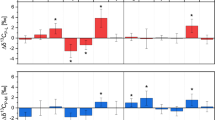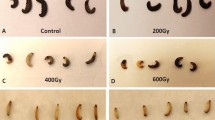Abstract
FOLLOWING successful attempts at marking Lepidopterous larvæ with radioactive sulphur with the object of investigating population dynamics, larval death-rate, and dispersal1, an opportunity presented itself of applying similar principles to locusts (Locusta migratoria L. and Locustana pardalina Walk.). Accordingly, a series of laboratory experiments was carried out on (a) locust hoppers and (b) locust adults. In each case, phosphorus-32 was given and feeding permitted for twenty-four or forty -eight hours, and this was followed by their return to normal food; thereafter, each having been anæsthetized by carbon dioxide, the individual counts per minute were recorded with a Geiger counter, as also were those for their excreta and exuviæ.
This is a preview of subscription content, access via your institution
Access options
Subscribe to this journal
Receive 51 print issues and online access
$199.00 per year
only $3.90 per issue
Buy this article
- Purchase on Springer Link
- Instant access to full article PDF
Prices may be subject to local taxes which are calculated during checkout
Similar content being viewed by others
References
Kettlewell, H. B. D., Nature, 170, 584 (1952).
Davey, J. T., Nature, 172, 720 (1953). Lea, A., Sci. Bull. Dep. Agric. S. Africa, No. 344 (Locust Research Series No. 15) (1953). Richards, O. W., Anti-Locust Bull., No. 15 (1953).
Author information
Authors and Affiliations
Rights and permissions
About this article
Cite this article
KETTLEWELL, H. Labelling Locusts with Radioactive Isotopes. Nature 175, 821–822 (1955). https://doi.org/10.1038/175821a0
Issue Date:
DOI: https://doi.org/10.1038/175821a0
This article is cited by
Comments
By submitting a comment you agree to abide by our Terms and Community Guidelines. If you find something abusive or that does not comply with our terms or guidelines please flag it as inappropriate.



